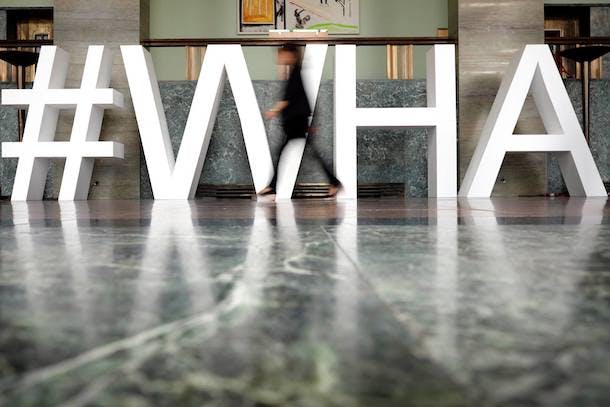There was a new vibe in Geneva last week – and it wasn’t just the musicians serenading the delegates as they entered the Assembly Hall in the Palais des Nations.
This was the first World Health Assembly under the leadership of Director-General Tedros Adhanom Ghebreyesus, the former Ethiopian health minister and foreign minister who was elected at last year’s Assembly and took office on July 1. He placed his imprint on the week by spearheading a fun walk/run event on May 20 to help celebrate the World Health Organization’s (WHO’s) 70th year.
Rwandan President Paul Kagame opened the Assembly on May 21 with an address describing Rwanda’s efforts to achieve universal health coverage, a signature issue of Dr. Tedros. While some are critical of Kagame’s governing style, he’s made undeniable strides in improving public health. His community-based approach has led to the steepest reductions in child and maternal mortality ever recorded across the country. It should come as no surprise that Dr. Tedros, who has a Ph.D. in community health, wanted to highlight the fundamental importance of making a difference on the ground, at the community level.
In his speech at the opening of the Assembly, Dr. Tedros made that point clear: “Targets, plans, strategies, guidelines, and meetings, although important, are not ends in themselves; they are not the reason we exist. The reason we exist is people: to promote health, keep the world safe, and serve the vulnerable.”
He also referred to a letter that Chancellor Merkel of Germany, President Akufo-Addo of Ghana, and Prime Minister Solberg of Norway sent to him in April. They proposed that WHO develop with other global actors a “Global Action Plan for Healthy Lives and Well-Being for All” ahead of the World Health Summit in Berlin in October. Dr. Tedros told the audience that the request “sends a strong signal from the international community that they expect stronger cooperation among partners, and that they are looking to us to lead that process.” It appeared Tedros was eager to oblige.
Debates, drafting sessions, and events focused on subjects ranging from global health security (as the world commemorates the 100th anniversary of the deadly “Spanish Flu” pandemic) to improving infant and young child nutrition to polio eradication and the transition of polio-funded assets after the disease is wiped out. As the UN prepares for the third high-level meeting on non-communicable diseases in September (as well as a high-level meeting on tuberculosis), there were hours of discussions on protecting people from dying too young from heart and lung diseases, cancers, and diabetes.
At my 12th consecutive WHA, I have come to appreciate the gathering’s pivotal role in highlighting neglected areas of public health – like this year’s call for action on snakebites, which kill as many as 138,000 people a year in predominantly poor, rural, and tropical communities.
Although the countless debates and events on a wide array of global health issues had the trappings of a traditional WHA, this gathering was different. The first days were dominated by discussion of WHO’s draft 13th General Programme of Work(GPW 13), Dr. Tedros’ vision for the organization.
The GPW 13 comprises the “triple billion,” interconnected strategic priorities based on the Sustainable Development Goals: 1 billion more people benefiting from universal health coverage; 1 billion more people better protected from health emergencies; and 1 billion more people enjoying better health and well-being.
WHO makes no pretense of doing this alone but will play a catalytic role working with governments, civil society organizations, the private sector, other international organizations, and many others. In essence, GPW 13 is intended to achieve measurable impact for people at the country level.
Following committee consideration, the assembly on Friday, May 25 approved GPW 13 by consensus. The Member States welcomed “its ambitious vision as expressed by the aspirational ‘triple billion’ goals” but also made it clear that its endorsement did not imply approval of financial estimates. They called on the Director-General to use GPW 13 as “the basis for the strategic direction of planning, monitoring, and evaluation of WHO’s work during the period 2019–2023, and to develop program budgets in consultation with Member States, based on a realistic assessment of income and WHO’s capacity.”
WHA 71 may prove to be pivotal in the history of the World Health Organization: When 194 Member States unanimously expressed support for the transformation of WHO to achieve ambitious health goals and to become the agile and flexible organization that the world needs it to be.
But Dr. Tedros is not resting on his laurels. He is about to embark on an ambitious effort to fully finance GPW 13, which will require funding beyond WHO’s current assessed and voluntary contributions.
He is streamlining and strengthening WHO’s engagement with donors and other partners and is developing an investment case to be launched in the near future. A financing campaign will endeavor to change the nature of WHO financing by advocating for flexible, sustainable, and predictable funding. The world has seen the power of flexible global health funding in the recent Ebola outbreak in the Democratic Republic of Congo: WHO was able to mobilize $2 million from its Contingency Fund for Emergencies to kick start the rapid response. An estimated $26 million will be needed for three months of emergency operations.
In his opening address, Dr. Tedros concluded by making it clear he was anxious to move ahead: “I am proud of the progress we have made so far. But we are only getting started.” After approval of the GPW 13 and progress on a wide range of public health issues, it’s clear that the World Health Organization under new leadership is off to a great start.
[Photo: WHO/Laurent Cipriani]

